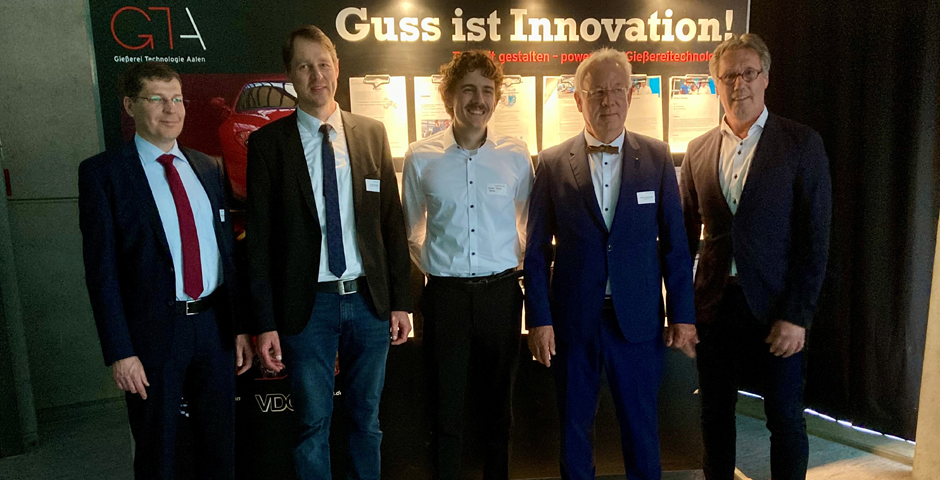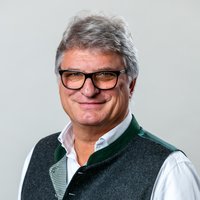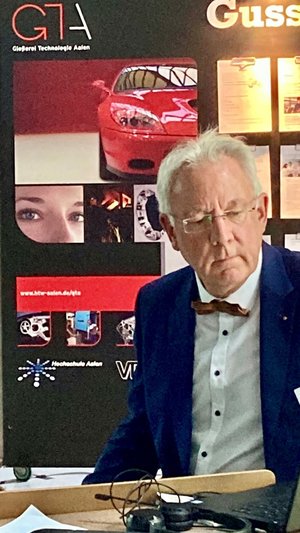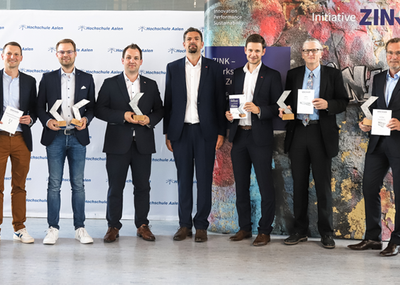Another highlight was the presentation of the Zinc Die Casting Award 2024 by Frank Neumann from Initiative Zink. In this context, zinc, a sometimes perhaps underestimated material, was able to clearly demonstrate its relevance and diverse application possibilities in practice and presented some outstanding results. --> foundry-planet.com - B2B Portal: Initiative ZINK -10th Zinc Die Casting Prize - Here are the winners!
As always, the event was rounded off with current contributions on research topics at Aalen University and a proper foundry evening. The event has become an integral part of our calendar, both in terms of content and socialising, and we are already looking forward to next year.
About the lecture series in detail:.
Klaus Hansen from Volvo Cars in Gothenburg opened the lecture series with his presentation on "Lessons learned optimising casting flow for Megacastings". Volvo is currently commissioning the first large die casting machines for large aluminium castings in Europe. A second factory is currently being built in Kosice, Slovakia, and is scheduled for completion in 2026.
The second factory next to Gothenburg will have a building footprint of approximately 300,000 square metres and will produce 250,000 cars per year. It is important to note that further potential space could be used to mirror the entire plant to produce 500,000 cars per year.
When planning the factory, particular emphasis was placed on material flows. In contrast to the "just in time" strategy, Volvo has integrated an extraction buffer that allows thorough inspections of the produced parts. The main challenge, however, according to Mr Hansen, was to abandon the traditional idea of "we've always done it this way" and embrace new things.
Dr. Marcel Pfitzer from Mercedes-Benz AG in Sindelfingen then spoke on the topic of "Sustainable use of materials in the body". The sustainable corporate strategy of Mercedes-Benz AG is made up of the areas of ecology, social affairs and economy. In the luxury segment in particular, lightweight construction and therefore cast aluminium are becoming increasingly important. The supply chains are also to be adapted towards sustainability by 2039 using a three-stage approach. Dr Pfitzer highlighted the topic of topology optimisation: this allows the component weight to be further reduced, which was also presented in a short film presentation using various components called BioniCast®.
Stefan Prockl from Bühler AG in Switzerland spoke about "Megacastings: A Suitability Analysis". In view of global warming and the resulting environmental disasters, there is growing pressure from regulatory authorities and interest groups to reduce greenhouse gas emissions in the automotive industry. An LCA study conducted by Bühler compares die-cast aluminium and stamped steel parts for the production of a rear underbody in terms of their respective impact on global warming. All emissions up to Scope 3 are recorded using a new calculation approach. The study shows how important environmentally friendly produced raw materials, the energy required for production and an increased proportion of recycled material are in order to reduce the CO2 footprint. Megacasting can be used to create more sustainable, lighter castings that enable a further reduction in CO2.
Dr. Werner Fragner from AMAG Austria Metall AG also gave a presentation on the topic of "Recycled casting alloy with a low CO2 footprint for safety components". The newly developed recycled casting alloy AlSi7.REC, which is going into series production at AUDI for safety-critical components and also has to fulfil high design requirements, was presented. A recycling content of > 70 % plays a central role here. The recycled alloy clearly shows what happens when the tolerance limits of materials that have been established for decades are scrutinised and adapted. The alloy used by Audi for wheel rims passes all load tests from the "curb test" to the "kerb test" and fulfils the requirements for strength and corrosion.
Marco Bottin from the company FORM S.R.L. spoke on the subject of "Innovative concept and materials for die casting moulds". Test series on "High Temperature Die Casting" were presented. Here, a graphite mould heated to a high temperature is used to produce thin-walled parts at a slow mould filling speed. To evaluate the process, a case study was carried out on a PC monitor holder, which led to the following results: reduced pressures and melting speeds are possible, spraying is not necessary, which can shorten the cycle time.
Christoph Dörr from TRUMPF Laser- und Systemtechnik GmbH explained the "Advantages in die casting using carbon steels from the 3D printer". The well-known advantages of 3D-printed, near-contour cooling are low surface temperatures, which enable micro-spraying and thus an increased service life of the inserts. Cycle time savings can also be achieved through near-contour cooling of the sprue distributor. With near-contour temperature control, efficient, homogeneous and immediate temperature control of the runner surface can be realised. Steels containing carbon are particularly suitable for use in die casting as they can withstand the abrasive behaviour of aluminium and the high process temperatures.
Dr. Andreas Mertz then presented the topic of "Gigacasting - targeted use of peripheral equipment". The FX VAC vacuum system can reduce the amount of gas/air in the mould cavity and casting system by up to 95% if set correctly. With the FX-JET jet cooler, hot spots can be cooled by evaporative cooling, which reduces shrinkage, porosity and build-up. The flexible squeeze system FX-Squeeze performs localised replenishment of die-cast parts, thereby avoiding shrinkage porosity.
Current research topics at Aalen University:
Dr. Heidi Willing gave a presentation on the "Influence of hydrogen ingress on the galvanic coatability of zinc die castings and development of measures to prevent it (ZiBe3)". It was found that no hydrogen permeation occurred in zinc foils (99.9 %) and Zamak (Z410) over 200 hours. Tests using hot gas extraction showed that untreated and high-quality copper-plated samples contained hardly any hydrogen. In contrast, samples with poor casting quality showed significant differences in hydrogen content. A significant hydrogen content was detected in nickel-plated samples in particular, which was also confirmed by the GDOES analysis. The investigations showed that the hydrogen is deposited in the copper and nickel layers, particularly in samples with poor surface quality. Various measures were proposed to prevent the formation of hydrogen: optimisation of the casting parameters to reduce surface defects, mechanical post-treatment to reduce cold spots and an adapted rinsing technique after electrolytic degreasing and activation during electroplating.
Max Schütze reported on the use of multi-layer sand cores in die casting. The project, funded by the German Research Foundation (DFG - 505145110), is being carried out in collaboration with the utg at the Technical University of Munich. In order to be able to precisely determine the loads on the sand core, a test rig was developed that simulates liquid aluminium with water. The results of the first series of tests on the surface quality of the die-cast parts have also already been presented. Video recordings of the decomposition of the core with molten aluminium in the die-casting machine are planned.
Annike Bossert presented "Innovative hybrids made of wood and die-casting" and discussed the project process as well as ecological and economic aspects. The advantages of these hybrids include the lightweight construction potential, the low-cost raw materials and the CO2 storage effect. The aim is to develop a wood-cast hybrid construction method as an efficient enabler technology for wood in vehicle structures.
Dr. Marcel Becker and Thomas Weidler spoke about "Vacural® die casting for the production of innovative lightweight components made of aluminium and magnesium". Using the example of a gearbox cover, the lightweight construction potential of aluminium and magnesium was demonstrated as part of the Indructec-E research project. By optimising the cast part, the component weight could be reduced by 34% for aluminium and 51% for magnesium. In addition, the costs could be reduced by > 40 % and the CO2 footprint by > 60 %.
Valentin Ziegler explained "Properties of a secondary alloy depending on the alloy composition - AlSi10MnMg". The strength is positively influenced by the increase in the recycled content, but the elongation decreases to some extent at significantly higher contents. The corrosion resistance decreases with higher copper and zinc contents and the thermal conductivity is partially superimposed by the heat treatment. During the investigation, a CO2 footprint of 1.2 kgCO2/kg was achieved and a recycling rate of 85 % was simulated. This project was carried out in co-operation with Handtmann.
Axel Kansy concluded the series of lectures with his presentation "Investigation of the cyclic properties of zinc die casting". It was found that the process parameters have no clear influence on the quasi-static material behaviour and that the tensile strength and elongation at break of the thicker samples is higher. A higher stress amplitude was found for ZP0430 compared to ZP0410. In the metallographic investigations, there is a significant correlation between wall thickness and average grain size.











